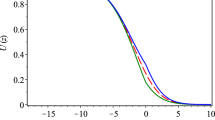Abstract
This paper concerns ecological invasion phenomenon of species based on the diffusive Lotka–Volterra competition model. We investigate the spreading speed (or the minimal wave speed of traveling waves) selection to the model and concentrate on the conjecture raised by Roques et al. (J Math Biol 71(2):465–489, 2015). By using an abstract implicit function theorem in a weighted functional space coupled with a perturbation technique, we not only prove this conjecture, but also show that the fast decay behavior of the first species is necessary and sufficient for the nonlinear speed selection of the whole system. This may lead to further significant results on the answer to the original Hosono’s conjecture, a problem that has been outstanding for more than twenty years.
Similar content being viewed by others
References
Alhasanat A, Ou C (2019a) Minimal-speed selection of traveling waves to the Lotka–Volterra competition model. J Differ Equ 266(11):7357–7378
Alhasanat A, Ou C (2019b) On a conjecture raised by Yuzo Hosono. J Dyn Differ Equ 31(1):287–304
Amarasekare P (2003) Competitive coexistence in spatially structured environments: a synthesis. Ecol Lett 6(12):1109–1122
Hosono Y (1998) The minimal speed of traveling fronts for diffusive Lotka–Volterra competition model. Bull Math 60(3):435–448
Hozler M, Scheel A (2012) A slow pushed front in a Lotka–Volterra competition model. Nonlinearity 25(7):2151–2179
Huang W (2010) Problem on minimum wave speed for Lotka–Volterra reaction-diffusion competition model. J Dyn Differ Equ 22(2):285–297
Huang W, Han M (2011) Non-linear determinacy of minimum wave speed for Lotka–Volterra competition model. J Differ Equ 251(6):1549–1561
Kan-on Y (1997) Fisher wave fronts for the Lotka–Volterra competition model with diffusion. Nonlinear Anal 28(1):145–164
Kolar CS, Lodge DM (2001) Progress in invasion biology: predicting invaders. Trends Ecol Evol 16(4):199–204
Lewis MA, Li B, Weinberger HF (2002) Spreading speed and linear determinacy for two-species competition models. J Math Biol 45(3):219–233
Li B, Weinberger HF, Lewis MA (2005) Spreading speeds as slowest wave speeds for cooperative systems. Math Biosci 196(1):82–98
Liang X, Zhao X-Q (2007) Asymptotic speed of spread and traveling waves for monotone semiflows with applications. Commun Pure Appl Math 60(1):1–40
Lonsdale WM (1999) Global patterns of plant invasions and the concept of invasibility. Ecology 80(5):1522–1536
Mack RN, Simberloff D, Lonsdale WM, Evans H, Clout M, Bazzaz FA (2000) Biotic invasions: causes, epidemiology, global consequences, and control. Ecol Appl 10(3):689–710
Okubo A, Maini PK, Williamson MH, Murray JD (1989) On the spatial spread of the grey squirrel in Britain. Proc R Soc Lond Ser B Biol Sci 238:113–125
Roques L, Hosono Y, Bonnefon O, Boivin T (2015) The effect of competition on the neutral intraspecific diversity of invasive species. J Math Biol 71(2):465–489
Shea K, Chesson P (2002) Community ecology theory as a framework for biological invasions. Trends Ecol Evol 17(4):170–176
Sher AA, Hyatt LA (1999) The disturbed resource-flux invasion matrix: a new framework for patterns of plant invasion. Biol Invasions 1:107–114
Tang M, Fife P (1980) Propagating fronts for competing species equations with diffusion. Arch Rational Mech Anal 73:69–77
Volpert AI, Volpert VA, Volpert VA (1994) Traveling wave solutions of parabolic systems. Transaction on mathemathics monograph, vol 140. American Mathematical Society, Providence
Author information
Authors and Affiliations
Corresponding author
Additional information
Publisher's Note
Springer Nature remains neutral with regard to jurisdictional claims in published maps and institutional affiliations.
Chunhua Ou: This work is supported by the NSERC discovery Grant of Canada # 204509.
Rights and permissions
About this article
Cite this article
Alhasanat, A., Ou, C. On the conjecture for the pushed wavefront to the diffusive Lotka–Volterra competition model. J. Math. Biol. 80, 1413–1422 (2020). https://doi.org/10.1007/s00285-020-01467-0
Received:
Revised:
Published:
Issue Date:
DOI: https://doi.org/10.1007/s00285-020-01467-0



